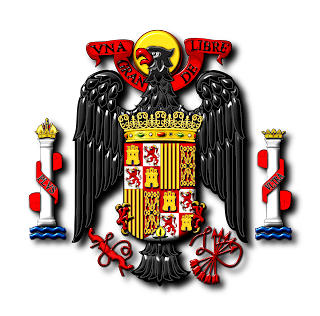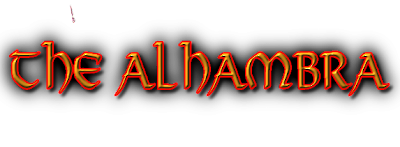
Reino de España
'Plus Ultra'
'Una, Grande y Libre'
The true origins of the name España and its cognates "Spain" and "Spanish" are disputed.
The ancient Roman name for Iberia, Hispania, may derive from poetic use of the term Hesperia to refer to Spain, reflecting the Greek perception of Italy as a "western land" or "land of the setting sun" (Hesperia, Εσπερία in Greek) and Spain, being still further west, as Hesperia ultima.
It may also be a derivation of the Punic Ispanihad, meaning "land of rabbits" or "edge", a reference to Spain's location at the end of the Mediterranean; Roman coins struck in the region from the reign of Hadrian show a female figure with a coney at her feet.
There are also claims that España derives from the Basque word Ezpanna meaning "edge" or "border", another reference to the fact that the Iberian peninsula constitutes the southwest of the European continent.
The humanist Antonio de Nebrija proposed that the word Hispania evolved from the Iberian word Hispalis, meaning "city of the western world".
Jesús Luis Cunchillos argues that the root of the term span is the Phoenecian word spy, meaning "to forge metals".
Therefore i-spn-ya would mean "the land where metals are forged".
The Falange Española de las Juntas de Ofensiva Nacional Sindicalista, FE de las JONS, (Spanish Phalanx of the Assemblies of the National Syndicalist Offensive), known simply as the Falange, is the name assigned to several Spanish political movements and parties dating from the 1930s, and dovetailed with the Fascist movement in Italy.
The word 'Falange' in Spanish refers to a 'Phalanx' formation, or front - a political metaphor commonly adopted by modern radicalised movements in the early-to-middle 20th century such as: Popular front, National Front or Vanguard .
Members of the party were called Falangistas (Falangists).
Since 1975, Falangists have split into several different political movements that have continued into the 21st century.
The main political movement that retained its Falangist heritage and is the continuation of the party is the FE JONS.
In Spain, the Falange was a political organization founded by José Antonio Primo de Rivera in 1933, during the Second Spanish Republic.
Primo de Rivera was a Madrid lawyer, son of General Miguel Primo de Rivera, who governed Spain as Prime Minister with dictatorial power under King Alfonso XIII in the 1920s.
General Primo de Rivera believed in state planning and government intervention in the economy.
His son and the Falangists he led expressed regret for the demise of the elder Primo de Rivera's regime, and proposed to revive his policies and a program of national-syndicalist social organization.
In Spanish heraldic tradition, the yoke, set of arrows and the Gordian Knot, were elements which were joined with the leaves and the pomegranate and the motto 'Tanto monta, monta tanto' (Equal opposites in balance), the personal motto and prenuptial agreement of the Catholic Monarchs Isabella I of Castile and Ferdinand II of Aragon. The bundle of arrows may have its origins in the Roman fasces, a bundle of rods and an axe with the blade projecting, that were carried before the magistrates to show their power. The Gordian knot, cut, united the two.
José Antonio Primo de Rivera y Sáenz de Heredia, 1st Duke of Primo de Rivera, 3rd Marquis of Estella (April 24, 1903 – November 20, 1936), was a Spanish lawyer, nobleman, politician, and founder of the Falange Española.
He was executed by the Spanish republican government during the course of the Spanish Civil War.
In Primo de Rivera's thinking the ultimate goal of the new political movement was the resurgence of Spain as a major power.
'We believe in the supreme reality of Spain. To strengthen her, to make her great is the paramount task of every Spaniard. Personal interest, collective or class interests must surrender to the achievement of this goal.'
Falange Española de las Juntas de Ofensiva Nacional Sindicalista
The Falange Española de las Juntas de Ofensiva Nacional Sindicalista, FE de las JONS, (Spanish Phalanx of the Assemblies of the National Syndicalist Offensive), known simply as the Falange, is the name assigned to several Spanish political movements and parties dating from the 1930s, and dovetailed with the Fascist movement in Italy.
The word 'Falange' in Spanish refers to a 'Phalanx' formation, or front - a political metaphor commonly adopted by modern radicalised movements in the early-to-middle 20th century such as: Popular front, National Front or Vanguard .
Members of the party were called Falangistas (Falangists).
Since 1975, Falangists have split into several different political movements that have continued into the 21st century.
The main political movement that retained its Falangist heritage and is the continuation of the party is the FE JONS.
In Spain, the Falange was a political organization founded by José Antonio Primo de Rivera in 1933, during the Second Spanish Republic.
Primo de Rivera was a Madrid lawyer, son of General Miguel Primo de Rivera, who governed Spain as Prime Minister with dictatorial power under King Alfonso XIII in the 1920s.
General Primo de Rivera believed in state planning and government intervention in the economy.
His son and the Falangists he led expressed regret for the demise of the elder Primo de Rivera's regime, and proposed to revive his policies and a program of national-syndicalist social organization.
Origin of the Yoke, Arrows and Gordian Knot
José Antonio Primo de Rivera
José Antonio Primo de Rivera y Sáenz de Heredia, 1st Duke of Primo de Rivera, 3rd Marquis of Estella (April 24, 1903 – November 20, 1936), was a Spanish lawyer, nobleman, politician, and founder of the Falange Española.
He was executed by the Spanish republican government during the course of the Spanish Civil War.
José Antonio Primo de Rivera
In Primo de Rivera's thinking the ultimate goal of the new political movement was the resurgence of Spain as a major power.
'We believe in the supreme reality of Spain. To strengthen her, to make her great is the paramount task of every Spaniard. Personal interest, collective or class interests must surrender to the achievement of this goal.'
Francisco Paulino Hermenegildo Teódulo Franco y Bahamonde
Caudillo de España, por la gracia de Dios
Coat of Arms of
Francisco Paulino Hermenegildo Teódulo Franco y Bahamonde
Caudillo de España, por la gracia de Dios
Francisco Franco y Bahamonde 4 December 1892 – 20 November 1975), was a Spanish general and leader of the Nationalist military revolution in the Spanish Civil War, and head of state of Spain, from October 1936 (as a unified nation from 1939 onwards) until his death in November 1975.
He came to power while recognizing the principles of the Falange movement.
As head of state, Franco used the titles Caudillo de España and Generalísimo.
Franco died just after midnight on 20 November 1975, at the age of 82, just two weeks before his 83rd birthday – the same date as the death of José Antonio Primo de Rivera, founder of the Falange.
The economic success of the latter part of his regime won support from many citizens - expressed admiration for Franco, stating that he "guaranteed the maintenance of traditional values in Europe".
Banner, royal standard and escutcheon of Franco
The banner and a royal standard were created in 1940 and then used until the death of Franco. The stripe between the two dragons separates the two Pillars of Hercules which have silver columns, gold Corinthian capitals and are headed with crowns. The crown nearest to the stripe, which is always on the column placed on the lower part of the flag, is an Imperial crown with a central upright bar. The one on the other column is a Royal crown, this has a more open top and it is always on the column placed on the top half of the flag. The Royal Bend of Castile, which was a personal badge of the Castilian Monarchs and later used by the House of Habsburg, was used as the basis for the creation of the escutcheon. The standard, the flag which was flown at official residences, barracks and on ships of the Spanish Navy, was a square with the elements mentioned above. La Banda de Castilla and the Columns of Hercules form part of the personal escuteon used by Franco as Chief of State. This shield also contained an accolade, the 'Laureate Cross of San Fernando' and an open crown without jewels known as the crown of military leadership
Valles De Los Caidos
La tumba de
Francisco Paulino Hermenegildo Teódulo Franco y Bahamonde
Caudillo de España, por la gracia de Dios
La tumba de
Francisco Paulino Hermenegildo Teódulo Franco y Bahamonde
Caudillo de España, por la gracia de Dios
Basílica Católica - Valle de los Caídos - Madrid
Valle de los Caídos - Cúpula
Escudo de Armas del Reino de España
(Arms of the Kingdom of Spain)
Puesta de sol sobre Granada
(Sunset over Granada)
Granada - España
Patio de los Leone
Granada - Alhambra - España



















No comments:
Post a Comment